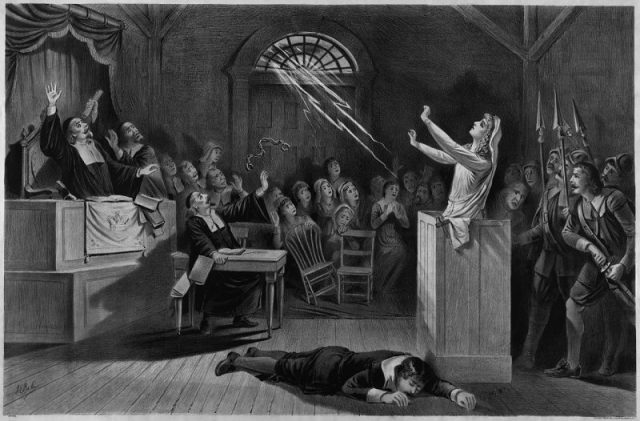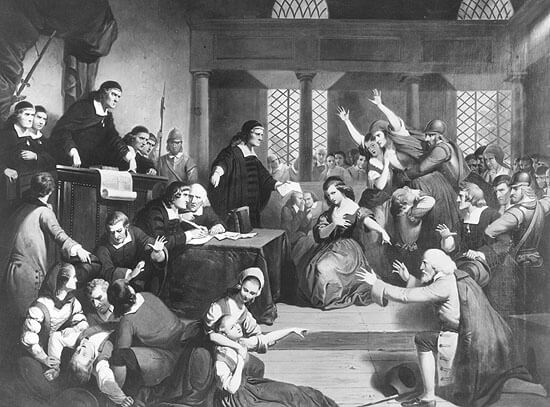The year is 1692, and you are one of approximately 550 residents in the small town of Salem Village. Your life is peaceful, and most of your days are spent tending to your crops . But your traditional way of life is about to be interrupted by a witch hunt that will scar you, your family, and your town for the rest of history – if you manage to survive. In this ESL lesson, which we discussed in a recent conversation class, we’ll take a look at one of the most horrifying events in North American history – The Salem Witch Trials.
So, what happened?
February, 1692 – Three young girls began exhibiting strange sicknesses – It was as if they were being tortured by the devil himself, with one of the girls claiming she was being “pinched and pricked ” as she convulsed on the floor of her family’s wooden house.
The girls, led by 12-year-old Ann Putnam Jr., immediately began accusing town locals of practicing witchcraft. The first “witches” arrested were Sarah Good (a homeless woman), Sarah Osborne (a woman who didn’t attend church), and Tituba (a slave from South America). In other words, three social outcasts who were disliked by the majority of the town.
Unsurprisingly, many citizens believed the testimony of the three sick girls, and the “witches” were quickly arrested. But soon after, Ann Putnam Jr. and her accomplices began accusing more and more villagers of also working for the Devil, until almost 200 of the local townspeople had an accusation against them. Of that group, 62 were arrested, 20 were executed, 4 died in prison, and 2 dogs were put down.
In other words…
If you were a resident of Salem Village in 1692, you had about a 12% chance of being arrested, and a 4% chance of being executed for witchcraft.
The hysteria of possible witchcraft in the town led the scared villagers to commit incomprehensible and inhumane actions against their neighbors. . But as the seasons passed, the panic began to slowly die down, until the April of the following year when the courts found all remaining “witches” not guilty, and released them once they paid their prison fines.
Thus ended the terror-filled year of witch trials in Salem Village.
Who were the accused?

If you were a resident of Salem Village in 1692, there was an approximately 30% chance you’d be accused of witchcraft – But that number rose significantly if you fit into one of the following groups:
- You were very young, or very old
Being an age outside of the ordinary was almost a guarantee that you’d face some accusations of colluding with the devil.
Rebecca Nurse was a 71 year old woman – an age that was uncommon to reach at the time due to the lack of knowledge on medicine and disease. As such, the town members immediately considered her an outlier . After all, how was she able to survive so many years… unless it was because of a deal she made with the Devil? Ms. Nurse was one of the first accused, and was executed for her supposed collusion almost immediately after.
The old weren’t the only people at risk of being targeted for their age, though. The accusers soon went after Dorothy Good, a 4 year old child and daughter of a homeless couple. Police arrested her, and placed her in jail for witchcraft, where she remained for 9 months. Her time in prison as a child barely old enough to talk caused her severe mental illnesses that ruined her chances at a normal life.
- You disagreed with the trials, or doubted the accusers
Some of Salem Village’s inhabitants disliked the ongoing witch hunt , which was undoubtedly interrupting the normalcy of life and leading to many, many deaths. But if you spoke out against the search for the Devil, it would likely result in you facing accusations just like everyone else. After all, why would you want to stop the search for wicked witches, UNLESS you were trying to protect them!
One villager by the name of John Proctor learned this the hard way. His wife, Elizabeth, had just been accused by the gang of mischievous girls, and John expressed his doubt. “Where is the proof?”, he pleaded … “How do we know the girls are telling the truth?”

This was a grave mistake , as the girls immediately accused him too. Abigail Williams, one of the original three accusers, stated that she was afflicted with curses, and came forward to say that she witnessed John choking and attacking her in a dream. This was enough proof in the eyes of many to warrant his execution. The police soon hanged his wife, and his death followed soon afterwards in the same manner.
- Someone wanted your land
Your neighbor has some really nice land. That apple tree is so beautiful… and it could be yours. Simply accuse your neighbor of being a servant of Satan, and take over his now-empty property once the town militia took them to prison. It was the perfect get-rich-quick scheme… until someone accused you for the same reason.
- You didn’t follow every rule in the Bible, or couldn’t remember every line
The residents of Salem Village were (clearly) extremely religious. As such, they followed a variety of strict and inflexible rules that would help them live a holy life. Deviating from these rules in any way, such as having hair too long, was a sign that you wished to challenge God. And, disagreeing with not just the religion, but also with God, could only mean one thing. You were a witch!
During trials, the judge would often ask the accused to recite lines from the Bible, since there was a belief that a witch could never speak the holy words. When reciting, if you misspoke a single word, it was considered evidence of your evil intentions, and the judge would order you to be executed.
- You had previously been accused of witchcraft
So you’ve been accused and acquitted by the courts – You’re safe now, right? Nope! A second accusation could easily send you back into the arms of the law . Several villagers, such as William Proctor, experienced this fate, and were forced to once again defend their innocence.
How did they know if you were a witch?

If a criminal is arrested for drug use, the police might take a blood sample for testing – but how are you supposed to test for witchcraft? In other words, how do you tell if an accused villager really works for the Devil?
Well, there were many different methods of tracking down witches and proving their collusion with the Devil. Let’s take a look at a few:
Spectral Evidence
It was believed that victims of witchcraft would see specters, or ghostly forms, of their tormentors while they were being attacked. So, if you were one of the town locals who was being abused by demonic powers, you would (supposedly) see an image of the witch who had chosen you as their next target – likely taunting you from her flying broomstick.
Even worse, the attacks didn’t have to necessarily be real. If a townsperson claimed to have seen you assaulting them in a dream, the courts considered it to be fact.
If a victim claimed to have seen your visage while experiencing the effects of a curse or spell, that was considered enough evidence to lock you away, or at the very least, put you under suspicion.
Spectral evidence, which required no testimony other than that of the victim, was one of the most widely methods ways of making accusations and convicting supposed witches. In fact, Ann Putnam Jr. (the leader of the accusers) used this method to blame over 60 townspeople. Clearly, she had many dreams.
Swimming Test
Fortunately, the town judges usually required more evidence that you were a witch before sentencing you to an early death. So, they returned to a staple of the demonic-influence genre – the swimming test.
You’ve been accused of witchcraft, so you’re already under suspicion. Now, it’s time to prove your guilt or innocence.
Here’s how it worked: You arms and legs would be tied together, so that you had absolutely no chance of fleeing or escaping – It was a method known as “hog-tying”. Then (pay attention now, this part is very technical) you would be thrown into a river.

Water was considered holy and blessed by God – So, witches would float because the water would “reject” their unholy presence. Innocents would sink to the bottom of the river and drown, unless they were pulled out in time.
In other words – If you sank to the bottom, drowned, and died before being pulled to the surface, you were innocent. If you floated to the surface and survived, it was proven that you were guilty of being a Devil-colluder, and you would immediately be sentenced to death.
Touch Test
Not all supposed witches were forced to participate in the illustrious river bath test, though. There was another surefire way of picking out the naughty villagers and deeming them guilty of devil-work – The touch test.
Many believed that victims of magic and sorcery would behave unusually when touched by the witch who was harming them – “so when a possessed person went into one of their frenzies, the suspected witch would be instructed to a lay a hand on them”.
The reaction of the girl determined the suspected witch’s fate. If the girl (who was experiencing the effects of the Devils torture ) ignored the sensation of a hand touching them, the accused was considered innocent. But, if the girl immediately became calm, there could be only one explanation – The person touching her… was a witch!
What was the punishment for witchcraft?
When you were convicted of witchcraft, there were only two options – death, or life in prison. The choice depended on whether or not you admitted to your crimes. If you remained adamant that you were innocent, you would be executed, usually via hanging. If you pled guilty and admitted to colluding with the Devil, you would be granted the generous offer of life in the 1600’s version of prison (which usually consisted of a dark, cold room filled with rats and bugs). The choice is yours!
One resident by the name of Giles Corey chose a third option – to not speak at all. This was likely his form of rebellion against the absurd trials, but not submitting a plea also meant the trial couldn’t continue, and his property would not be forfeited to the government. As he was accused and put on trial, he remained completely silent, not admitting to or denying his prestigious status as one of Satan’s’ closest friends.

The court needed a plea, whether it be guilty or innocent, from Giles’s mouth. Since he refused to speak and admit or deny his crimes, the town officials decided to use a torture method named peine forte et dure. In this process, “prisoners were stripped naked, and heavy boards were laid on their bodies. Then rocks or boulders were laid on the plank of wood until they are crushed to death, or they admit the information that is desired”. In total, it took two days for Giles to be crushed, in which the only words he spoke were “more weight!“.
How did it end?
As with almost any catastrophic event, there was no end until it threatened the government. After 19 citizens had been executed for their supposed demonic crimes, the accusers turned to a woman by the name of Lady Mary Phips. Unfortunately for the accusers, Mary Phips was the wife of Sir Phips, the governor of Massachusetts at the time.
Almost immediately after the “afflicted” girls blamed Lady Mary Phips, the governor signed an official order that ended the court proceedings of all accused witches in Salem. It read –
“I hereby declare that as soon as I came from fighting … and understood what danger some of (your) innocent subjects might be exposed to … (I realized that you must) put a stop to the proceedings of the Court and they are now stopped until their Majesties pleasure be known.”
— Governor Phips, Boston, October 12, 1692
In other words, no more witch hunts until the King could investigate and figure out why so many Salem villagers were being killed.
What happened to the accusers?

So, the witch hunt is over, and the remaining villagers are left to pick up the pieces. Now, what do you think they did with those three initial girls, led by Ann Putnam Jr, who started the massacre?
If you thought they would face punishment for their deeds, prepare to be disappointed. As far as the records go, each of the accusers continued on with as normal after the end of the trials, generally living long and pleasant lives.
Whether they truly believed their afflictions and the witches causing them were real or not is impossible to know, but only one of the accusers, Ann Putnam Jr., ever apologized for the event. She stated that she desired “to lie in the dust, and earnestly beg forgiveness from God and from all those unto whom I have given just cause of sorrow and offence.”
What could have started the Salem Witch Trials?
Well, there are three main theories as to what started the Salem Witch Trials.
- Mental illness – Mass hysteria
Mass hysteria is a mental illness in which the victims experience elevated levels of fear, panic, and awareness. This often affects people in groups when one victim begins showing symptoms. It is possible that one of the three original girls was facing unrelated mental illnesses that caused her to behave strangely, triggering the others to do the same, thus beginning a case of mass hysteria .
- Disease – Ergot poisoning

Infected wheat could be the culprit behind the strange behavior of Salem villagers. Ergot, a fungus that is closely related to the hallucinogen LSD, could have infected the wheat plants in Salem and entered the towns food supply. Ergot causes vivid hallucinations , and the accusers might have first truly believed the things the saw in their dreams because of this hallucinogen. But, this theory is problematic, as one medical historian states – “None of these suggested diseases fit because a close reading of the testimony suggests that the symptoms were intermittent. The afflicted had stretches of time when they acted perfectly normal… (along with times when they acted unusually).”
- A family feud
Perhaps most reasonable of all theories – it is believed that the trials began as a method of targeting and killing enemies of the original accusers. As it turns out, there was a feud between the Putnam family and Porter family in Salem Village. When Ann Putnam Jr. claimed that she was attacked by a witch, the first woman she accused was a supporter of the Porter family, who also had a land dispute with the Putnam’s.
It is possible that the trials began as a way to settle a decades-old family rivalry, and quickly spiraled out of control , as accused witches would in turn accuse others in order to save themselves. It was a classic case of “I’m guilty, but those two are guiltier!”.
In truth, it’s likely that we will never know exactly what caused the witch trials. But, we can be sure that they were fueled by fear, panic, and distrust among the citizens of Salem Village.
Movie and book recommendations
The Salem Witch Trials were a hugely influential source of history, and they give us an insight into the culture and personalities of those who lived in North America some-400 years ago.
As such, there are countless films, books, plays and other forms of entertainment based on the period. Here are some of my personal recommendations related to the topic.
The Crucible – Book
The Crucible is a famous play, widespread in American culture. Many high schools require their students to read this play, because of its cultural importance. The play focuses on the Salem witch trials, and tries to develop the characters so that it is easier for us, the audience, to understand their motivations and tribulations .
A quick warning, though – reading this play can be difficult. The author, Arthur Miller, wrote it in the old English used at the time of the story (late 1600’s). You can read the full play here for free.
The Crucible – Movie
The Crucible has also had several TV and film adaptations , with my favorite being the 1996 movie with Daniel Day Lewis and Winona Ryder. It’s a great movie, and a bit easier to understand than the book version.
The Witch – Movie
Finally, a horror movie inspired by the events of the Salem Witch Trials. This movie is an excellent example of how people from this time period viewed the threats of witches and demons, which can help you understand how the events of Salem Village occurred. Check it out!
For more ESL Lessons…
To practice your English with more lessons like this, feel free to return next week for another interesting blog post – Or, join our online English classes! Thanks for reading.
[qsm quiz=3]





